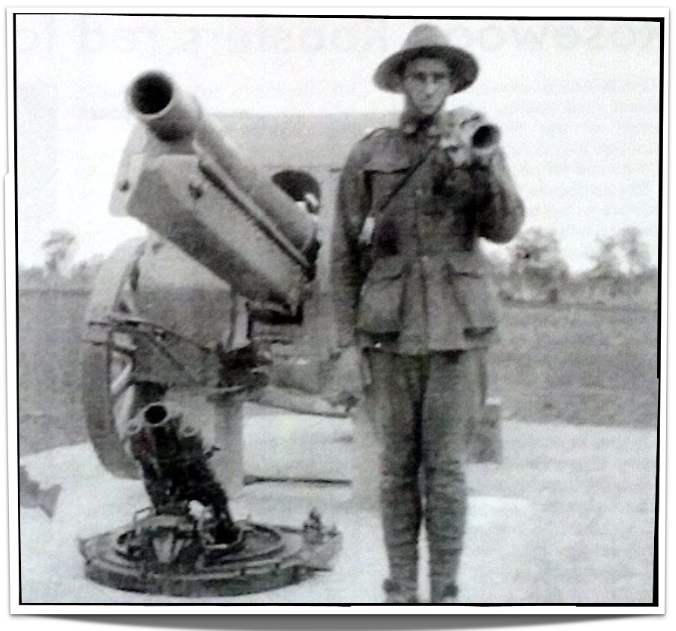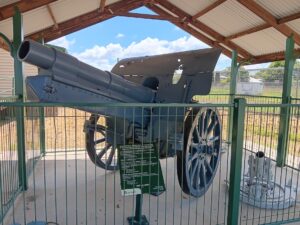
Rosewood History
Unveiling Rosewood’s War Trophies
In November 2021, at a Rosewood History Group gathering, I was shown the photo above. It had appeared in the Moreton Border News on 12th July 2002 under the heading “Who Is This Man?”. The accompanying article was about the war trophies located in a specially constructed shed next to the RSL Memorial Hall at Anzac Park, Rosewood. There was a 15cm Howitzer gun and 76mm German Trench Mortar which had been allocated to the town after the Great War. The article said that a machine gun was also sent to Rosewood but its whereabouts was unknown, and so was the identity of the bugler in the photo. Information was being sought.
I was surprised to be told that the RSL was still seeking that information 19 years later, so I set out to see if I could find the answer to the questions. I was able to pass on what I had found in early 2022.
In late 1916 the British War Office established a committee to deal with the disposal of war trophies and relics. It was decided that the best of them would go to the British National War Museum and the rest would be distributed to the dominion countries. However, the Australian government, along with other dominion countries insisted that the trophies claimed by their troops should come home to them.
After the end of WW1 the Queensland State War Trophy Committee distributed war trophies to townships having a population of over 150. On the 1st July 1920, at a Rosewood Shire Council meeting, a letter was read from the Committee saying that a machine gun had been allotted to Rosewood. The Council sent a reply saying that the offer was accepted with thanks.
In September that year the Rosewood branch of the R. S. S. I. L. A. met in the Farmers’ Hall. The president, Arthur Edward Adams, reported that the Shire Council had suggested the League appoint trustees for the war trophy which had been allotted to Rosewood. Several members expressed regret at the lack of public interest in having a memorial and thought the town should be proud to have it. Trustees were appointed:- James Arthur Wells (Chairman Rosewood Shire Council), Arthur Edward Adams and Edward John Hogan.
At a Council meeting in September 1921, the trustees tried to resign due to apathy and lack of public interest. Subscriptions had not been forthcoming to erect a shed to house the trophies. After a discussion the trustees’ resignation was held over and the chairman decided to call a public meeting to try and drum up public interest. He also wanted to discuss the planting of Anzac Park.
In October a letter was received from the War Trophies’ Committee advising that the machine gun had been forwarded to Rosewood.
In March 1922 the trustees of the Rosewood War Trophies successfully resigned their positions. It was suggested that new trustees be appointed to address the housing of the trophies. It was also agreed that an effort should be made to retain the trophies even if they were housed outside in the open. They decided to proceed with the work at a cost of £20.
The Queensland State Trophy Committee wrote again in May 1922 informing the Council that an additional field gun had been allotted to Rosewood. On the 27th July a 5.9 howitzer, which had been captured by the 11th Battalion, arrived at Rosewood. The gun was a very imposing spectacle and the town thought it was fortunate in securing such a trophy. It stood at the entrance to the railway station until it was permanently placed.
A new War Trophies Committee was formed on 21st August 1922 to arrange the placement and housing of the trophies. The members were Robert Sellars, Joseph Patrick Walsh, James Elder, George Hughes, Isaac Canham, Herbert Dutney, and Richard Bourne.
Several working bees were held. The first work done was in connection with the big howitzer. It was painted and logs were procured for a foundation. They were placed in position and securely spiked down. Another working bee was held a few weeks later with the ladies providing refreshments. By December the work on placing the gun in position was well underway. The Council sold the cement at cost price to the War Trophy Committee and a platform was cemented in February 1923.
The trophies faced the entrance to the Park and in mid April a roadway leading to the war trophies was made. The big gun was later placed in position with the anchor bolt holding the gun carriage in position. All of the spikes were supplied free of charge. Eight and a half tons of porphyry were placed on the road approach. Finally a wicket gate was placed at the entrance to keep the cattle out. This completed the work and the guns were mounted in readiness for the unveiling.
On the 6th April a meeting of citizens was held in the Shire Office to make arrangements for a fitting observance of Anzac Day. Rev. Thomas Edwards was the chairman. The following men were appointed as the committee: Revs. Henry Capern, Evangelist Horace Bassard, Captain Fred Evans, Messrs. Wilhelm August Zerner, Robert Sellars, Douglas Banks, James Elder, and James Wells.
On Anzac Day, the 25th April 1923, the ceremony for the unveiling of the war trophies was held. The day was observed as a holiday by schools and public offices and the business premises were closed from 11 a.m. to 2 pm. A general holiday atmosphere was felt in the town throughout the day.
The commemoration was a combination of three notable functions- the ceremony of unfurling and hoisting the A. and H. Association’s flag at the Farmers’ Hall at 10.a.m.; the unveiling of the war trophies and combined church service in Anzac Park at noon, and a public meeting in the Farmers’ Hall at night.
That morning at the Farmers’ Hall, Robert Sellars, the president of the Rosewood A. and H. Association, assisted by some pioneer members, hoisted the Union Jack and Australian flag on the new flag pole.The pole had been donated to the association by Mr. James Elder. It was painted white and set in a solid body of concrete, the latter work being done by A. Rodgers. The members who assisted were Messrs. Charles Freeman, John Freeman, Samuel Waight, Charles Mason, Charles Urry, John Jacobs, Henry McGeary, George Loveday, Thomas Coulsen, Harry Harding and Moses Freeman. Mrs James Dale (senior) was also invited to assist. The Light Horse under the command of Captain Fred Evans attended. Several speeches by old members were made. Hearty cheers were given at the conclusion of the ceremony and everyone present joined in singing the National Anthem. The flag was lowered to half-mast at noon.
A requiem Mass was conducted in St. Brigid’s Church by the Rev. Father Hayes that morning and a United Memorial Service was held at Anzac Park at noon. The Rev. Thomas Edwards presided. Speeches were delivered by the president, Evangelist Bassard and Mr. Henry Capern.
A guard of honour was formed by the returned servicemen and the Light Horse under Capt. Fred Evans and Sergt. Norman Bade.
Prior to the unveiling of the war trophies, the public joined in singing the hymn “Oh God Our Help” and the “Last Post” was sounded by Mr. W. Dawson. Mr. Robert Sellars, in inviting Major Harte to perform the unveiling ceremony, gave information regarding the trophies. He said the large 5.9 howitzer, which was captured by an Australian battalion in the great offensive on the Somme in 1918, was a modern weapon and carried a shell weighing one hundred pounds a distance of 12 miles. He added that the foundation on which the trophies rested had been so constructed that it would last for generations and added hat work was mostly voluntary.
The ceremony of unveiling the three guns was performed by Major A. E. Harte.The National Anthem and cheers for the returned soldiers, Major Harte and the Light Horse, concluded the function.
That night a public celebration of Anzac Day was held in the Farmers’ Hall. There was a large attendance and the Rev. T. E. Edwards presided. The gathering stood in silence as the chairman read the names of the fallen soldiers from the Rosewood district, and after one minute’s silence at 9 p.m., Mr. W. J. Dawson sounded the “Last Post”. The church bells were tolling at the same time adding to the moving atmosphere. During the proceedings the hymns “Nearer My God To Thee,” and “Abide With Me,” were sung. Miss D. Allen was the accompanist. The National Anthem concluded the night.
The secretary of the Rosewood War Trophies Committee applied for permission to plant two Crows Ash trees on either side of the gun in the Anzac Park. The request was referred to the Parks Committee. Subsequently when Cr. Walsh spoke of ordering a number of trees to plant round the boundaries of the park, they passed a motion that the trees be sourced from the Curator of the Brisbane Botanical Gardens.
As for the identity of the buglar….
William John Dawson aka John
- Born: 6th June 1895 at Gympie.
- Son of John Wilson Dawson and Hettie Isabella Daly.
- SERN 3072 – Enlisted at Maryborough 20th October 1916.
- 3rd Machine Gun Battalion (Sergeant)
- Embarked at Sydney per Wiltshire on 7th February 1917
- Married Florence May Jeffries (Tailoress) on 13th February 1919 at the Register Office, Shoreditch, London.
- Came home to Aberdeen Wharf, Millers Point, Sydney, Australia on the Megantic 5/3/1920.
- School Teacher – Head Teacher for 10 years at Calvert State School until December 1928.
- Methodist
- I.P.M. Lodge Rosewood 120 U.G.L. (1928)
- Played the cornet and euphonium.
- Played the Last Post on every Anzac Day while he lived in the Rosewood area.
- Died: 18th August 1942, Chillagoe, Queensland aged 47 years. He had been the Head Teacher there for 10 years.
- Buried: Chillagoe General Cemetery
This snippet about the Megantic is from the Warwick Daily News, 9th March 1920.
Is It Hot at Bourke! – The large number of English brides, Diggers, and dependents who arrived in Sydney by the steamer Megantic on Friday morning were given a cordial reception at the Anzac Buffet. The Diggers had no complaints to make but the brides with beads of perspiration rolling down their faces made anxious inquiries about the weather. “Does it get any hotter than this?” asked one, and immediately there was a renewed waving of handkerchiefs and wiping of faces. “I’m going to Bourke with my husband” chimed in a buxom young woman,” and I am told it is very hot there. Is it?” The reporter walked away.
John Dawson’s brother Thomas Temperley “Temp” Dawson also served. He farmed at Lanefield. (SERN Depot 58320 WW1; Service Number Q204048)
The wherabouts of the machine gun is still unknown.

Rosewood’s War Trophies at Anzac Park
© Jane Schy, 2024
